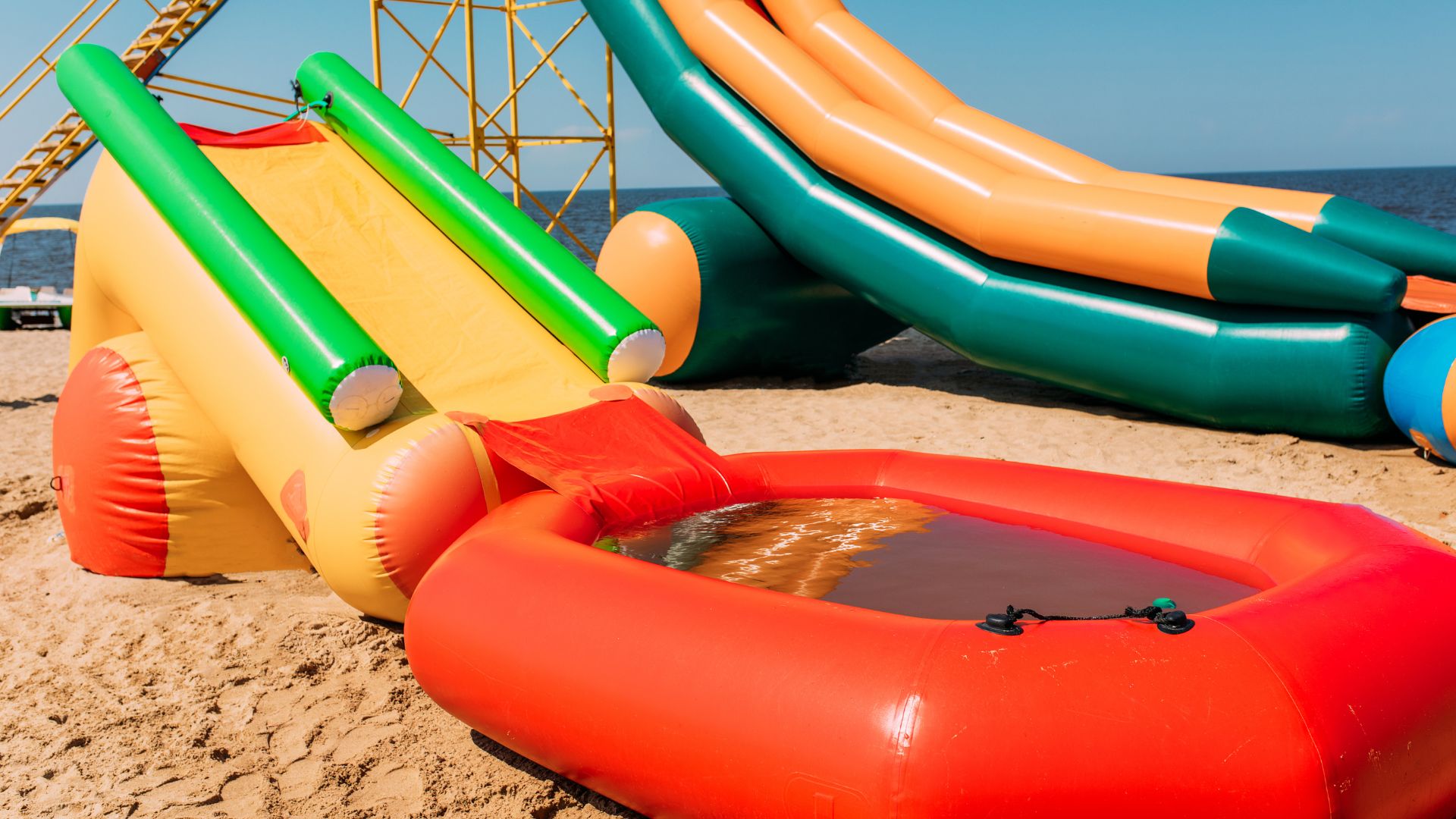No one wants a sad, droopy Christmas decoration. But what about those cheerful, bouncy inflatable decorations? Can they withstand a little rain?
Can you leave inflatable christmas decorations up in rain?
Yes, you can safely leave inflatable Christmas decorations up in the rain, but it’s important to follow the manufacturer’s instructions. Most inflatables are designed to withstand outdoor conditions, including rain and snowfall. However, make sure the transformer and electrical parts are protected from water. If heavy rainfall or snow is expected, consider the stability and safety of your decoration in such conditions, you should take it down.
When it comes to leaving them up in the rain, there are several considerations to keep in mind:
- Most inflatable decorations are made from nylon or polyester, which are naturally water-resistant materials. Hence, they can handle some amount of rain without being damaged.
- Many inflatable decorations come with built-in lights and electric fans to keep them inflated. If these components are not adequately protected or are not rated for outdoor use, exposure to rain could pose a risk of electrical malfunction or short-circuiting.
- Wet electrical cords and connections can increase the risk of electric shock. It’s crucial to ensure all connections are elevated off the ground, secure, and away from areas where water can pool.
- Wet grounds can affect the stability of the decorations. The pegs or weights used to secure the inflatable might become loose in soaked soil, making the decoration vulnerable to being blown away or toppled by wind.
- If the decorations remain wet for extended periods, they can become breeding grounds for mildew and mold. When deflating and storing them, ensure they are completely dry to prevent fungal growth.
- Constant exposure to rain and moisture can reduce the lifespan of the inflatable’s material, leading to potential leaks and reduced structural integrity over time.
- Always refer to the manufacturer’s guidelines regarding exposure to rain. Some inflatables may be explicitly designed to withstand rain, while others might have limitations.
- Rainwater can cause the inflatable to sag or collapse if the internal fan isn’t powerful enough to compensate for the additional weight of the water.
- Consider using waterproof covers or placing inflatables under awnings or other protective structures if rain is expected. This not only shields them from water but also prolongs their lifespan.
In conclusion, while many inflatable Christmas decorations can handle some rain, it’s essential to consider their specific features, the severity of the rain, and safety concerns. It’s often advisable to deflate and store them indoors during heavy rain or storms to ensure their longevity and safety.
can inflatables get wet
Yes, inflatable decorations can get wet without significant harm. Most inflatables are made from water-resistant materials like PVC or vinyl, which are designed to handle moisture and light water exposure. However, while these materials can resist water to an extent, it’s essential to avoid prolonged soaking and to dry the lawn inflatables thoroughly after they get wet. This prevents potential water damage and maintains their longevity. In summary, inflatables can withstand getting wet due to their water-resistant materials, but proper care should be taken to dry them to ensure their durability and safety.
Can you leave inflatables outside?
Yes, you can leave inflatables outside, but their suitability for outdoor conditions largely depends on their material. Inflatables, also known as blow-ups or air-filled objects, are often made from materials like PVC, nylon, or vinyl, which offer varying degrees of durability. Heavy-duty PVC or vinyl inflatables are more resistant to outdoor elements, such as sunlight, rain, and temperature changes. It’s important to protect them from extreme weather conditions like heavy rain, strong winds, or prolonged sun exposure to avoid damage.
- Type of Inflatable:
- Recreational inflatables: Items like inflatable pools, floaties, and water loungers are typically designed for outdoor use. However, prolonged exposure to the elements can degrade the material, causing it to become brittle or faded.
- Holiday inflatables: These are often designed to be temporary decorations and can generally handle short-term outdoor exposure. Some are more weather-resistant than others, so it’s essential to check the manufacturer’s guidelines.
- Inflatable boats or kayaks: These are designed to be used outdoors but should be stored indoors when not in use to extend their lifespan.
- Weather Considerations:
- Sunlight: Prolonged exposure to UV rays can cause inflatables to fade and weaken the material, making it more prone to punctures or tears.
- Rain: While some inflatables might be water-resistant, continuous exposure to moisture can lead to mold and mildew, especially in seams or crevices.
- Wind: Strong winds can cause inflatables to move, tumble, or even fly away, leading to potential damage or loss.
- Temperature: Extreme cold can make some inflatable materials brittle, while extreme heat can cause them to overinflate or weaken.
- Duration:
- Short-term exposure (like a day at the beach or a night of festive decoration) usually won’t harm inflatables, especially if they’re appropriately secured and monitored.
- Long-term exposure, however, can increase the risk of damage from the elements, animals, or vandalism.
- Security:
- Inflatables, especially larger ones or those of high value, can be targets for theft or vandalism when left unattended outside.
- Care and Maintenance:
- Regularly check for any signs of wear, tear, or damage.
- Clean the inflatable after use to remove dirt, debris, or any chemicals (like chlorine from pool water).
- If leaving outside, ensure it’s securely anchored to prevent it from being blown away or toppled over by wind.
- When not in use for extended periods, it’s best to deflate, clean, dry, and store the inflatable indoors.
- Manufacturer’s Guidelines: Always check and follow the manufacturer’s recommendations for storage and outdoor use. Some inflatables may have specific guidelines about outdoor exposure.
In conclusion, while many inflatables are designed for outdoor use, continuous or long-term exposure to the elements can lead to wear and damage. It’s always a good idea to monitor the local weather conditions, regularly inspect and maintain your inflatables, and store them indoors when not in use to ensure their longevity and optimal performance.
Can you leave Christmas inflatables on all the time?
Yes, you can leave Christmas inflatables on all the time, but it’s not recommended. Continuous operation can lead to wear and tear, reducing the inflatable’s lifespan. It’s better to use a timer to turn them off during the day and back on in the evening. This approach also saves energy and prevents potential overheating. Always follow the manufacturer’s guidelines for safe usage and consider your inflatable’s specific design and features.
Is it Safe to Leave Inflatables Outside During Winter Snowfall?
Yes, you can keep inflatables outside during snowfall, but with caution. Most inflatables are made from materials like PVC or vinyl, which can tolerate cold temperatures to a certain extent. However, extreme cold and heavy snow can be challenging, as they may cause the material to become brittle and more susceptible to damage.
It’s advisable to avoid leaving inflatables out in severe snowy conditions for extended periods. If they are used during snowfall, make sure they are properly anchored and check regularly for any signs of damage or deflation. In summary, while inflatables can be kept outside in snow, taking precautions to protect them from harsh winter conditions is essential for their longevity and safety.
Are inflatables OK in the rain?
Yes, inflatables are generally OK in the rain. Most are designed to be used outdoors and can handle light to moderate rain. However, it’s important to protect the electrical components, like the transformer, from water. Always follow the manufacturer’s instructions for specific guidance. During heavy rain, it’s a good idea to deflate and store them to avoid damage. Regular checks for any water-related wear and ensuring they’re securely anchored can also help keep your inflatables safe in rainy conditions.
How to dry out inflatable decorations
Drying out inflatable decorations effectively is important to prevent mold and mildew, especially if they have been exposed to rain, and moisture or used outdoors. Here’s a step-by-step guide:
- Inflate the Decoration: Inflate the decoration fully. This helps to open up all the parts of the inflatable, making it easier to dry every area.
- Wipe Down the Exterior: Use a clean, dry cloth to wipe down the exterior of the decoration. If there are any wet or damp spots, make sure to dry them thoroughly.
- Spot Clean if Necessary: If there are any dirty spots, gently clean them with a mild detergent and a damp cloth. Avoid using harsh chemicals or scrubbing too hard, as this can damage the material.
- Air Dry: Let the decoration air dry completely. The best way to do this is by leaving it inflated in a well-ventilated area or outdoors on a dry, sunny day. Make sure every part of the inflatable, including crevices and folds, is completely dry.
- Use a Fan: For quicker drying, you can use a fan to circulate air around the inflatable. Position the fan so that air flows over the entire surface of the decoration.
- Check for Dampness: Before storing the decoration, check for any remaining dampness, especially in areas where water might collect.
- Deflate and Store: Once the decoration is completely dry, deflate it carefully. Fold or roll it up, avoiding sharp bends or creases that could damage it.
- Store in a Dry Place: Store the deflated decoration in a cool, dry place. Avoid places with extreme temperatures or humidity. A storage bag or container can protect it from dust and pests.
How do you store outdoor inflatables?
Storing outdoor inflatables properly ensures they remain in optimal condition and are ready for use when the next season or occasion arrives. Proper storage also extends the life of these inflatables, whether they’re used for holidays, poolside fun, or other events. Here’s a comprehensive guide to storing outdoor inflatables:
- It’s essential to clean inflatables before storing them. Use mild soapy water and a soft cloth to wipe down the inflatable, removing dirt, debris, and any stains. Ensure no harsh chemicals are used, as they can damage the material.
- Moisture can lead to mold and mildew. Inflate the item and let it air dry for several hours to ensure all parts, especially crevices and folds, are completely dry.
- Deflation – Gradually deflate the inflatable, starting from the end furthest from the air intake. As the air is released, press gently on the inflatable to push out any remaining air.
- Avoid Sharp Objects: Ensure that the storage space is free from sharp objects that could potentially puncture or damage the inflatable. Keep it away from tools, sharp edges, or other items that could cause harm.
- Stakes or Weights: If your inflatable has stakes or weights to secure it to the ground, remove them before storing. Store them separately and label them for easy retrieval when you set up the inflatable again.
- Fold or Roll With Care – Once fully deflated, fold or roll the inflatable gently, avoiding sharp folds. Sharp bends or folds can create weak points in the material over time.
- Use Original Packaging When Possible – Many inflatables come with a storage bag or box. If available, use this original packaging as it’s often tailored to the item’s size and shape.
- Consider Storage Bins – For inflatables without original packaging or for added protection, use a sturdy plastic storage waterproof container with a secure lid that can protect the inflatable from moisture, dust, and pests.
- Label Everything – If you have multiple inflatables, label each storage container or bag with the inflatable’s description and any essential care instructions.
- Climate Control is Key – Store inflatables in a cool, dry place. Avoid locations with extreme temperature fluctuations, like attics or uninsulated garages. These environments can cause the material to degrade faster.
- Avoid Weight on Top – Store inflatables at the top of storage areas or ensure that no heavy items are placed on them. Excessive weight can damage the inflatable or cause deformations.
- Inspect and Repair – Before packing away for storage, inspect your inflatables for any damage. Small tears or holes can be patched up with repair kits suitable for inflatables. Addressing these issues before storage can save you from discovering them when it’s time to use the inflatable again.
- Protect from Pests – Ensure the storage area is free from rodents or insects. Consider adding mothballs or other repellents to deter pests.
- Store Electrical Components Separately – If your inflatable has lights, fans, or other electrical components, store them separately in a clearly labeled bag or box. Ensure cords are coiled neatly to avoid tangling or damage.
- Store in a Reachable Area – Place inflatables where they can be easily accessed. This encourages regular checks, ensuring they remain in good condition.
- Check for UV Protection: If you are storing the inflatables outdoors, consider using a tarp or cover to protect them from UV rays. UV exposure can cause fading and deterioration over time.
By adhering to these storage guidelines and checking your inflatables periodically, you can maintain their quality and enjoy their use for many years to come. Proper storage also prevents unexpected surprises when it’s time to set them up for the next event or holiday season.
Do inflatable Christmas decorations use a lot of electricity?
No, inflatable Christmas decorations do not use a lot of electricity. In fact, they are very efficient when it comes to energy usage. The average inflatable Christmas decoration uses only about 3 watts of power. That is about the same amount of power that a night light uses.
Are inflatable decorations a fire hazard?
Inflatable decorations are generally not a fire hazard when used correctly. They are made from materials that are usually fire-resistant and are safe for outdoor use. However, it’s crucial to follow safety guidelines. Ensure that the inflatable’s electrical components, like cords and transformers, are in good condition and not overloaded. Keep inflatables away from open flames or heat sources. Regularly inspecting them for any damage and following the manufacturer’s instructions will help ensure safe and enjoyable use.
How do you protect inflatables from wind?
When it comes to protecting your inflatables from wind, there are a few things you can do. First, make sure that you inflate your inflatables completely. This will give them more stability in windy conditions. You can also try to secure your inflatables to the ground with stakes or sandbags. If you have a particularly large inflatable, you may want to consider anchoring it down with ropes or straps. Finally, keep an eye on the forecast and try to avoid inflating your inflatables on days when strong winds are expected.
How do you protect outdoor Christmas decorations from wind?
One of the best ways to protect your outdoor Christmas decorations from wind is to tie them down using stakes by doing this, you can ensure that your decorations are less likely to be blown away or damaged by strong winds.
– tying down: This will help to ensure that your decorations are secured and less likely to be blown away by strong winds.
– using stakes: Similar to tying down, using stakes can help to keep your decorations in place and prevent them from being blown away.
– placing in a sheltered area: If you have the option, placing your outdoor Christmas decorations in a sheltered area can help to protect them from strong winds.
– Use wind-resistant materials: When choosing materials for your outdoor Christmas decorations, opt for ones that are less likely to be blown away by strong winds.
By following these tips, you can help to ensure that your outdoor Christmas decorations are protected from wind damage.
How do you care for inflatable decorations?
Caring for inflatable decorations is essential to prolong their lifespan, maintain their aesthetic appeal, and ensure they function optimally. To maintain them, clean with mild detergent and water, ensuring they’re dry before storing. It’s essential to avoid over-inflation and to be cautious of extreme weather conditions.
Check regularly for minor damages, repairing them promptly. When storing, deflate fully and keep in a cool, dry place. Ensure the installation area is free from sharp objects, and always use outdoor-rated extension cords for power. Secure them well to prevent them from being blown away, and avoid continuous operation to prevent wear. Always refer to the manufacturer’s guidelines for specific care instructions.
Let’s unpack the information in the latent space regarding the care and maintenance of inflatable decorations:
- Inflation and Deflation:
- Slow and Steady: Inflate and deflate the decoration slowly to prevent strain on the seams and material.
- Avoid Overinflation: Overinflating can stress the seams and material, leading to potential damage. Always follow the manufacturer’s guidelines for inflation levels.
- Placement:
- Smooth Surface: Always place your inflatable on a smooth, flat surface free of sharp objects, stones, or debris that could puncture the material.
- Away from Obstructions: Keep inflatables away from trees, fences, or any obstructions that could rub against them and cause wear or damage.
- Secure Anchoring: Ensure your inflatable is securely anchored to prevent it from being blown away or toppling over, especially in windy conditions. Use stakes, ropes, or sandbags as recommended.
- Exposure to Elements:
- UV Protection: Continuous exposure to direct sunlight can cause colors to fade and weaken the material. If possible, use UV protective sprays or position inflatables in shaded areas.
- Weather Conditions: While many inflatables are water-resistant, avoid letting them sit in standing water or heavy snow. In the event of severe weather, it’s best to deflate and store the decoration indoors.
- Cleaning and Maintenance:
- Routine Checks: Regularly inspect the inflatable for any signs of wear, tear, or damage.
- Cleaning: Use a mild detergent and water to clean off dirt or stains. Make sure to rinse thoroughly and let the inflatable dry completely before storing.
- Patch Kits: Many inflatables come with patch kits. If a small hole or tear appears, follow the instructions to patch it up as soon as possible.
- Storage:
- Complete Deflation: Ensure the decoration is entirely deflated, making it easier to fold and store.
- Dry Thoroughly: Before storing, make sure the inflatable is completely dry to prevent mold or mildew.
- Fold Carefully: Avoid creasing or folding too tightly, which could damage the material or internal structures. Roll or fold the inflatable loosely.
- Storage Bags: If provided, use the original bag or box for storage. Otherwise, use a large tote or storage container. Store in a cool, dry place away from direct sunlight.
- Electrical Components:
- Ensure the power source is dry and away from water sources.
- Unplug when not in use and inspect cords regularly for wear or damage. Replace if needed.
- Store electrical components, such as fans or lights, in a dry place when not in use.
- Safety Considerations:
- Always follow the manufacturer’s guidelines for safe use.
- Keep inflatables away from open flames or heat sources.
In essence, with proper care, cleaning, and storage, inflatable decorations can last for several seasons, providing joy and aesthetic appeal. Regular maintenance not only preserves their function but also ensures they remain safe to use.
Are inflatable Christmas decorations waterproof?
If you’re wondering whether those inflatable Christmas decorations are waterproof, wonder no more! Inflatable Christmas decorations are made from nylon or other synthetic materials that are durable and waterproof, so they can withstand the elements. Just be sure to avoid placing them where puddles typically form.
Do inflatables need to be unplugged when it rains?
Yes, it is generally recommended to unplug inflatables when it rains. There are several reasons to consider this precautionary measure:
- Safety: Water and electricity are a hazardous combination. Even if the inflatable is designed to be water-resistant, there’s a risk of water seeping into electrical components, leading to potential short circuits or electrocution hazards.
- Preservation of Decoration: Rainwater can collect in parts of the inflatable, adding weight and strain to the material. This could cause the inflatable to sag, stretch, or even tear under the additional weight.
- Electrical Components: The fan or blower that keeps the inflatable upright is typically protected from light rain or moisture, but heavy rain could allow water to enter the motor, which may damage it.
- Ground Conditions: Rain can soften the ground, making stakes or anchors less effective. This could result in the inflatable being dislodged or blown away in windy conditions.
- Longevity: Repeated exposure to rain without adequate drying can lead to mold or mildew growth on the inflatable, reducing its lifespan and aesthetic appeal.
Can I Leave my inflatable decorations outside in the winter?
Yes, many inflatable decorations are designed for outdoor use during the winter season, especially those made specifically for holiday themes like Christmas. However, there are considerations and precautions to take if you decide to leave them outside:
- Weather Conditions: It’s crucial to monitor the weather. While inflatables can handle cold, they might not fare well with heavy snowfall, sleet, or freezing rain. Snow accumulation can weigh them down, possibly causing damage or inhibiting the fan’s operation. If harsh weather is predicted, it’s a good idea to deflate and store them temporarily.
- Material Stiffness: Cold temperatures can make the material of the inflatable less flexible. This isn’t usually a problem unless you’re trying to move or adjust the inflatable in very cold conditions, which might increase the risk of cracking or tearing.
- Ground Anchoring: If the ground freezes, it can make the stakes or anchors less effective. This could potentially result in the inflatable being dislodged, especially in windy conditions. Ensure they’re securely anchored.
- Condensation and Ice: The temperature difference between the air blown into the inflatable and the outside environment can lead to condensation inside the decoration. In freezing temperatures, this moisture can turn into ice, which might damage the decoration.
- Sun Exposure: While winter sun is less intense, UV rays can still cause wear and fading over time. Consider this if you’re placing the inflatable in a particularly sunny spot.
- Safety: As with rain, it’s essential to ensure that electrical components are kept dry. The power cord and power outlet should be checked for any ice or snow buildup, and electrical connections should be elevated off the ground to avoid contact with melted snow.
- Periodic Checks: Regularly inspect your inflatables for any signs of damage, wear, or accumulation of snow or ice. Doing so will help prolong their life and ensure they’re functioning correctly.



